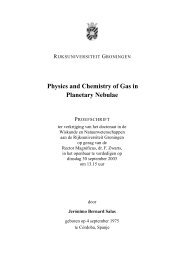TRACING ABUNDANCES IN GALAXIES WITH THE SPITZER ...
TRACING ABUNDANCES IN GALAXIES WITH THE SPITZER ...
TRACING ABUNDANCES IN GALAXIES WITH THE SPITZER ...
You also want an ePaper? Increase the reach of your titles
YUMPU automatically turns print PDFs into web optimized ePapers that Google loves.
2.5 Data Analysis<br />
Our goal is to calculate element abundances in IC 2448. In order to do this,<br />
we must first determine the extinction toward and physical conditions within the<br />
nebula. We iterate to find self-consistent solutions for the electron density and<br />
temperature. Then we use the derived values of extinction, electron density, and<br />
electron temperature to derive ionic abundances. Finally we sum the observed<br />
ionization stages of each element to derive total elemental abundances.<br />
2.5.1 Extinction Correction<br />
We calculate the amount of interstellar extinction in two ways. First, we compare<br />
the observed Hβ flux for the whole nebula with the Hβ flux predicted from infrared<br />
hydrogen recombination lines for case B recombination for a gas at Te = 10 000<br />
K and Ne = 1000 cm −3 using the theoretical hydrogen recombination line ratios<br />
from Hummer & Storey (1987). The H I(7-6) and H I(11-8) are blended in the<br />
spectrum, and theoretically the H I(11-8) line should be 12.26% of the H I(7-6) line<br />
(Hummer & Storey, 1987); thus this amount is subtracted out before predicting<br />
the Hβ flux from the H I(7-6) line. The results are shown in Table 2.4. Using the<br />
average predicted Hβ flux from that table, and the total observed Hβ flux of 1410<br />
× 10 −14 erg cm −2 s −1 (Acker et al., 1992), we obtain CHβ=0.33.<br />
The second method we use to determine the extinction is to compare the ob-<br />
served Hβ flux to that predicted by the 6 cm radio flux using the following equation<br />
from Pottasch (1984):<br />
F (Hβ) =<br />
S6cm<br />
2.82 × 10 9 t 0.53 (1 + He + /H + + 3.7He ++ /H + )<br />
where t is the electron temperature in 10 4 K and 2.82×10 9 does the unit conversion<br />
so that S6cm is in Jy and F(Hβ) is in erg cm −2 s −1 . Using ionic helium abundances<br />
40













